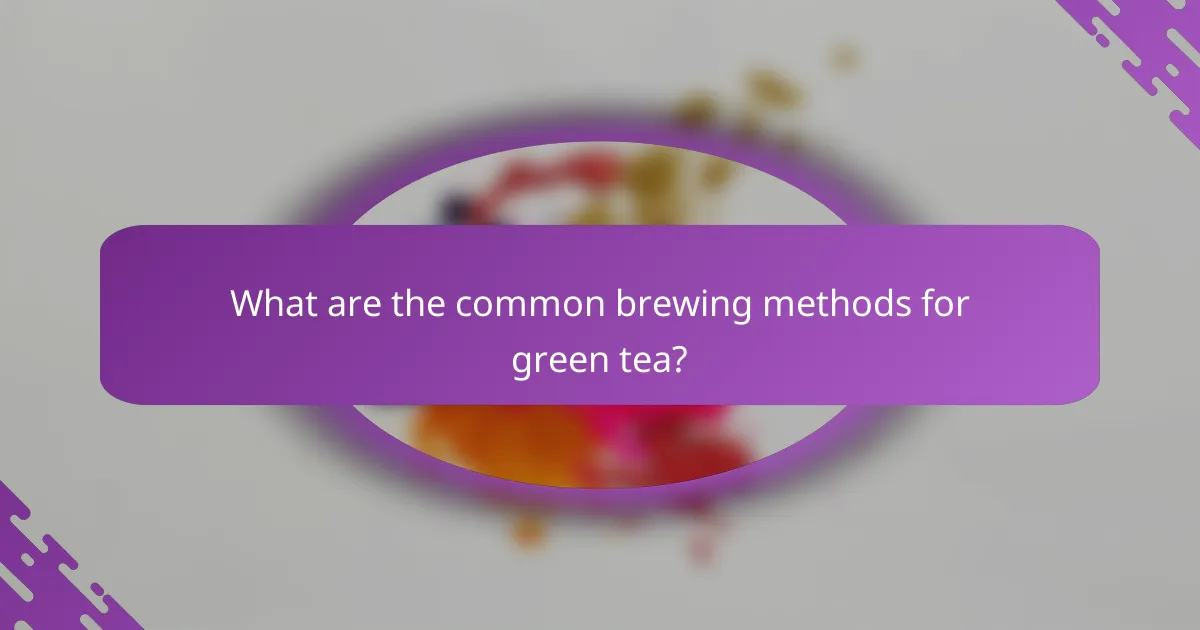Green tea is celebrated for its diverse flavor profiles, ranging from fresh and vibrant to subtle and earthy, each contributing to its unique appeal. With a caffeine content of 20 to 45 milligrams per 8-ounce cup, it offers a gentler alternative to coffee and black tea. To achieve the best flavor, brewing time should be carefully monitored, typically lasting between one to three minutes to avoid bitterness or weakness in taste.

What are the flavor profiles of green tea?
Green tea offers a diverse range of flavor profiles, characterized by its fresh, vibrant taste. The primary flavors can be categorized into several distinct notes, each contributing to the overall experience of this popular beverage.
Vegetal and grassy notes
Vegetal and grassy notes are often the most prominent flavors in green tea. These flavors stem from the young leaves and buds used in production, which are minimally processed. Varieties like Sencha and Gyokuro are particularly known for their bright, green, and slightly sweet grassy flavors.
When brewing green tea, the temperature and steeping time can significantly affect these vegetal notes. Using cooler water (around 70-80°C) and steeping for a shorter duration (1-2 minutes) helps preserve the fresh, grassy taste.
Floral and fruity undertones
Many green teas exhibit delicate floral and fruity undertones, adding complexity to their flavor profiles. Teas like Jasmine Green and some high-quality Longjing (Dragon Well) can present hints of flowers such as jasmine or even subtle fruity notes reminiscent of stone fruits.
To enhance these floral and fruity flavors, consider using slightly warmer water (about 80-85°C) and a longer steeping time (2-3 minutes). This approach can help to extract the aromatic compounds without overwhelming the palate.
Nutty and toasty flavors
Nutty and toasty flavors are more common in certain roasted green teas, such as Hojicha. The roasting process imparts a warm, toasty character that balances the natural sweetness of the leaves. This flavor profile is often described as comforting and smooth.
For those who enjoy these nutty notes, brewing Hojicha with boiling water (around 90-100°C) and steeping for 30 seconds to 1 minute can bring out the best of its toasted flavor without bitterness.
Earthy and umami characteristics
Some green teas, particularly those grown in shaded conditions like Matcha, possess earthy and umami characteristics. These flavors contribute to a rich, savory taste that can be quite satisfying. The umami flavor is often described as brothy or savory, enhancing the overall depth of the tea.
To fully appreciate these earthy and umami notes, prepare Matcha using water at around 70-80°C and whisk it for about 30 seconds. This method helps to release the full spectrum of flavors while maintaining a smooth texture.

How much caffeine is in green tea?
Green tea typically contains about 20 to 45 milligrams of caffeine per 8-ounce cup, depending on various factors such as the type of tea and brewing method. This amount is generally lower than that found in coffee and black tea, making it a popular choice for those seeking a milder caffeine boost.
Typical caffeine content per cup
The caffeine content in green tea can vary significantly based on the specific variety and preparation method. On average, a standard cup of brewed green tea contains around 30 milligrams of caffeine. However, certain types, like matcha, can have higher levels, sometimes exceeding 70 milligrams per serving due to the consumption of whole tea leaves.
Comparison with black tea
Black tea generally contains more caffeine than green tea, with typical levels ranging from 40 to 70 milligrams per cup. This makes black tea a stronger option for those seeking a more pronounced caffeine effect. The difference in caffeine content is largely due to the longer oxidation process that black tea undergoes, which affects its chemical composition.
Factors affecting caffeine levels
Several factors influence the caffeine levels in green tea, including the type of tea leaves used, the brewing time, and the water temperature. For instance, using hotter water and steeping the tea for longer can extract more caffeine. Additionally, the age and quality of the leaves can also play a role, with younger leaves typically containing higher caffeine concentrations.
Brewing techniques can further impact caffeine extraction. For example, steeping green tea for 2 to 3 minutes at around 80 to 85 degrees Celsius is often recommended to balance flavor and caffeine content effectively. Adjusting these variables allows tea drinkers to customize their caffeine intake according to personal preference.

What is the ideal brewing time for green tea?
The ideal brewing time for green tea typically ranges from one to three minutes, depending on the specific type and desired flavor profile. Over-steeping can lead to bitterness, while under-steeping may result in a weak taste.
Recommended steeping duration
For most green teas, a steeping duration of two to three minutes is recommended. This allows the leaves to release their flavors without becoming overly astringent. For delicate varieties like Japanese gyokuro, aim for a shorter steep of about one to two minutes.
Using a timer can help ensure you don’t exceed the recommended steeping time. If you prefer a stronger flavor, consider increasing the amount of tea leaves rather than extending the brewing time.
Impact of water temperature on brewing
Water temperature significantly affects the extraction of flavors in green tea. Generally, water should be heated to around 70-80°C (158-176°F) for optimal brewing. Higher temperatures can extract more bitterness, while lower temperatures may not fully develop the tea’s flavor.
Using a thermometer or an electric kettle with temperature settings can help achieve the right heat. If you don’t have these tools, allow boiling water to cool for a few minutes before pouring it over the tea leaves.
Variations by green tea type
Different types of green tea require varying steeping times and temperatures. For example, Chinese green teas like Longjing (Dragon Well) typically steep well at 80°C (176°F) for about two to three minutes. In contrast, Japanese teas like sencha thrive at slightly lower temperatures of around 70°C (158°F) for one to two minutes.
Understanding these nuances can enhance your brewing experience. Always refer to specific recommendations for the tea you are using, as this can vary widely among different brands and styles.

What are the health benefits of green tea?
Green tea offers numerous health benefits, primarily due to its rich content of antioxidants and other beneficial compounds. Regular consumption can support weight management, improve heart health, and provide protective effects against various diseases.
Antioxidant properties
Green tea is packed with antioxidants, particularly catechins, which help combat oxidative stress in the body. These compounds can neutralize free radicals, reducing cell damage and lowering the risk of chronic diseases.
To maximize antioxidant intake, consider brewing green tea at lower temperatures (around 70-80°C) for a shorter duration, typically 2-3 minutes. This method preserves more catechins compared to higher temperatures.
Weight management support
Green tea may assist in weight management by boosting metabolism and enhancing fat oxidation. The caffeine and catechins work together to increase energy expenditure, which can help with weight loss efforts.
Incorporating 2-3 cups of green tea daily can be beneficial, but it’s essential to combine it with a balanced diet and regular exercise for optimal results. Avoid adding excessive sugar or milk, as this can counteract its benefits.
Heart health improvement
Regular consumption of green tea has been linked to improved heart health, including lower cholesterol levels and reduced blood pressure. The antioxidants in green tea can help improve blood vessel function and reduce inflammation.
Studies suggest that drinking 3-5 cups per day may provide significant cardiovascular benefits. However, individuals with specific health conditions should consult a healthcare professional before making substantial changes to their tea consumption.

How to choose the best green tea?
Choosing the best green tea involves considering factors like quality, flavor, and brand reputation. Look for fresh, high-quality leaves and reputable brands to ensure a satisfying experience.
Quality indicators to look for
When selecting green tea, examine the leaf appearance and aroma. High-quality green tea typically features vibrant, whole leaves that are fragrant. Avoid dusty or broken leaves, as these often indicate lower quality.
Additionally, check for the harvest date. Freshness is key; ideally, the tea should be consumed within a year of harvest. Look for packaging that includes this information to ensure optimal flavor and health benefits.
Popular brands in the UK
Several brands are well-regarded for their green tea offerings in the UK. Brands like Twinings and Pukka are known for their quality and variety, providing options that cater to different tastes.
Another popular choice is Dragonfly Tea, which emphasizes organic and ethically sourced products. For those seeking premium options, brands like Harney & Sons offer high-end selections that are often praised for their rich flavors and aromas.

What are the common brewing methods for green tea?
Common brewing methods for green tea include traditional Japanese techniques and Western-style approaches. Each method emphasizes different aspects of flavor extraction and preparation, affecting the overall taste and experience of the tea.
Traditional Japanese methods
Traditional Japanese brewing methods focus on precision and respect for the tea’s delicate flavors. The most notable technique is the use of a kyusu, a small teapot designed specifically for brewing green tea. Water temperature should be around 70-80°C (158-176°F), and steeping time typically ranges from 1 to 3 minutes, depending on the tea variety.
Another method is the use of a tea bowl, particularly in the preparation of matcha. In this case, powdered tea is whisked with hot water, creating a frothy beverage. This technique emphasizes the umami flavor and vibrant green color of the tea.
Western-style brewing techniques
Western-style brewing techniques often prioritize convenience and can vary widely. A common method involves using a tea infuser or tea bag, with water heated to about 80-90°C (176-194°F). Steeping time usually lasts between 2 to 4 minutes, allowing for a balanced flavor without bitterness.
Some enthusiasts prefer using a French press for brewing green tea, which allows for easy control over steeping time and temperature. This method can enhance the tea’s aromatic qualities while providing a fuller body compared to traditional methods.
